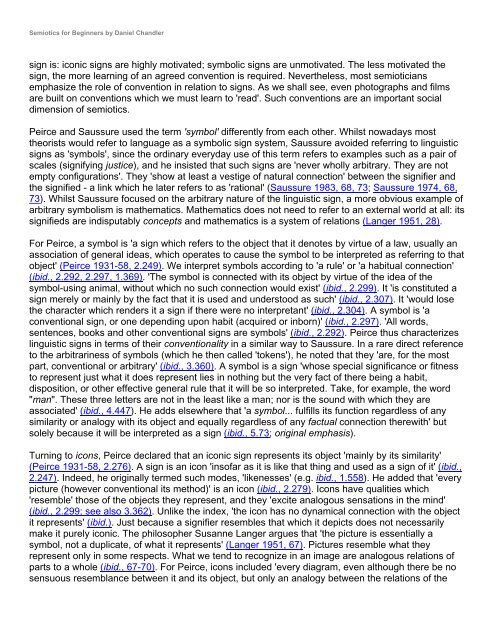Semiotics for Beginners by Daniel Chandler
Semiotics for Beginners by Daniel Chandler
Semiotics for Beginners by Daniel Chandler
You also want an ePaper? Increase the reach of your titles
YUMPU automatically turns print PDFs into web optimized ePapers that Google loves.
<strong>Semiotics</strong> <strong>for</strong> <strong>Beginners</strong> <strong>by</strong> <strong>Daniel</strong> <strong>Chandler</strong><br />
sign is: iconic signs are highly motivated; symbolic signs are unmotivated. The less motivated the<br />
sign, the more learning of an agreed convention is required. Nevertheless, most semioticians<br />
emphasize the role of convention in relation to signs. As we shall see, even photographs and films<br />
are built on conventions which we must learn to 'read'. Such conventions are an important social<br />
dimension of semiotics.<br />
Peirce and Saussure used the term 'symbol' differently from each other. Whilst nowadays most<br />
theorists would refer to language as a symbolic sign system, Saussure avoided referring to linguistic<br />
signs as 'symbols', since the ordinary everyday use of this term refers to examples such as a pair of<br />
scales (signifying justice), and he insisted that such signs are 'never wholly arbitrary. They are not<br />
empty configurations'. They 'show at least a vestige of natural connection' between the signifier and<br />
the signified - a link which he later refers to as 'rational' (Saussure 1983, 68, 73; Saussure 1974, 68,<br />
73). Whilst Saussure focused on the arbitrary nature of the linguistic sign, a more obvious example of<br />
arbitrary symbolism is mathematics. Mathematics does not need to refer to an external world at all: its<br />
signifieds are indisputably concepts and mathematics is a system of relations (Langer 1951, 28).<br />
For Peirce, a symbol is 'a sign which refers to the object that it denotes <strong>by</strong> virtue of a law, usually an<br />
association of general ideas, which operates to cause the symbol to be interpreted as referring to that<br />
object' (Peirce 1931-58, 2.249). We interpret symbols according to 'a rule' or 'a habitual connection'<br />
(ibid., 2.292, 2.297, 1.369). 'The symbol is connected with its object <strong>by</strong> virtue of the idea of the<br />
symbol-using animal, without which no such connection would exist' (ibid., 2.299). It 'is constituted a<br />
sign merely or mainly <strong>by</strong> the fact that it is used and understood as such' (ibid., 2.307). It 'would lose<br />
the character which renders it a sign if there were no interpretant' (ibid., 2.304). A symbol is 'a<br />
conventional sign, or one depending upon habit (acquired or inborn)' (ibid., 2.297). 'All words,<br />
sentences, books and other conventional signs are symbols' (ibid., 2.292). Peirce thus characterizes<br />
linguistic signs in terms of their conventionality in a similar way to Saussure. In a rare direct reference<br />
to the arbitrariness of symbols (which he then called 'tokens'), he noted that they 'are, <strong>for</strong> the most<br />
part, conventional or arbitrary' (ibid., 3.360). A symbol is a sign 'whose special significance or fitness<br />
to represent just what it does represent lies in nothing but the very fact of there being a habit,<br />
disposition, or other effective general rule that it will be so interpreted. Take, <strong>for</strong> example, the word<br />
"man". These three letters are not in the least like a man; nor is the sound with which they are<br />
associated' (ibid., 4.447). He adds elsewhere that 'a symbol... fulfills its function regardless of any<br />
similarity or analogy with its object and equally regardless of any factual connection therewith' but<br />
solely because it will be interpreted as a sign (ibid., 5.73; original emphasis).<br />
Turning to icons, Peirce declared that an iconic sign represents its object 'mainly <strong>by</strong> its similarity'<br />
(Peirce 1931-58, 2.276). A sign is an icon 'insofar as it is like that thing and used as a sign of it' (ibid.,<br />
2.247). Indeed, he originally termed such modes, 'likenesses' (e.g. ibid., 1.558). He added that 'every<br />
picture (however conventional its method)' is an icon (ibid., 2.279). Icons have qualities which<br />
'resemble' those of the objects they represent, and they 'excite analogous sensations in the mind'<br />
(ibid., 2.299; see also 3.362). Unlike the index, 'the icon has no dynamical connection with the object<br />
it represents' (ibid.). Just because a signifier resembles that which it depicts does not necessarily<br />
make it purely iconic. The philosopher Susanne Langer argues that 'the picture is essentially a<br />
symbol, not a duplicate, of what it represents' (Langer 1951, 67). Pictures resemble what they<br />
represent only in some respects. What we tend to recognize in an image are analogous relations of<br />
parts to a whole (ibid., 67-70). For Peirce, icons included 'every diagram, even although there be no<br />
sensuous resemblance between it and its object, but only an analogy between the relations of the




